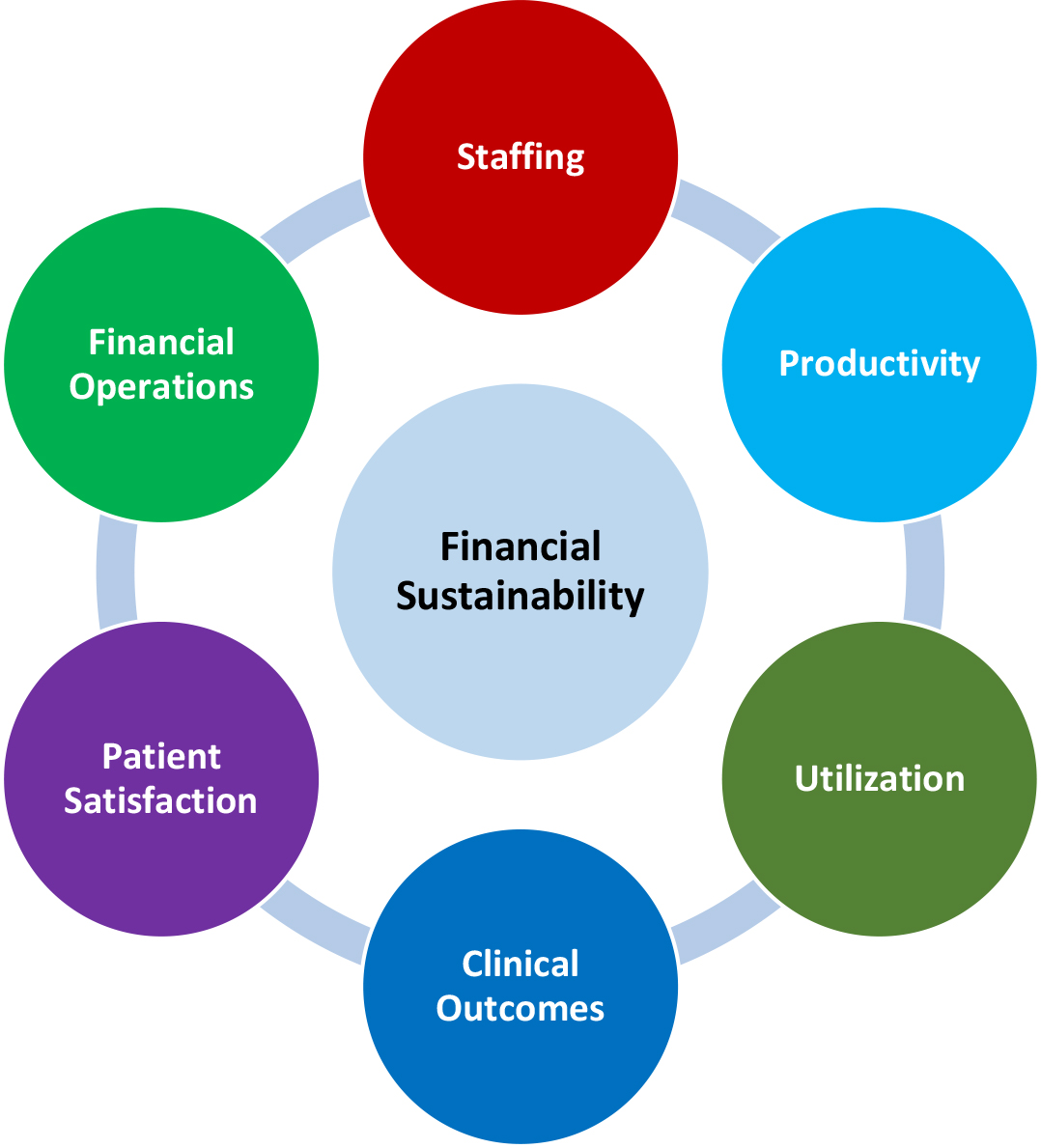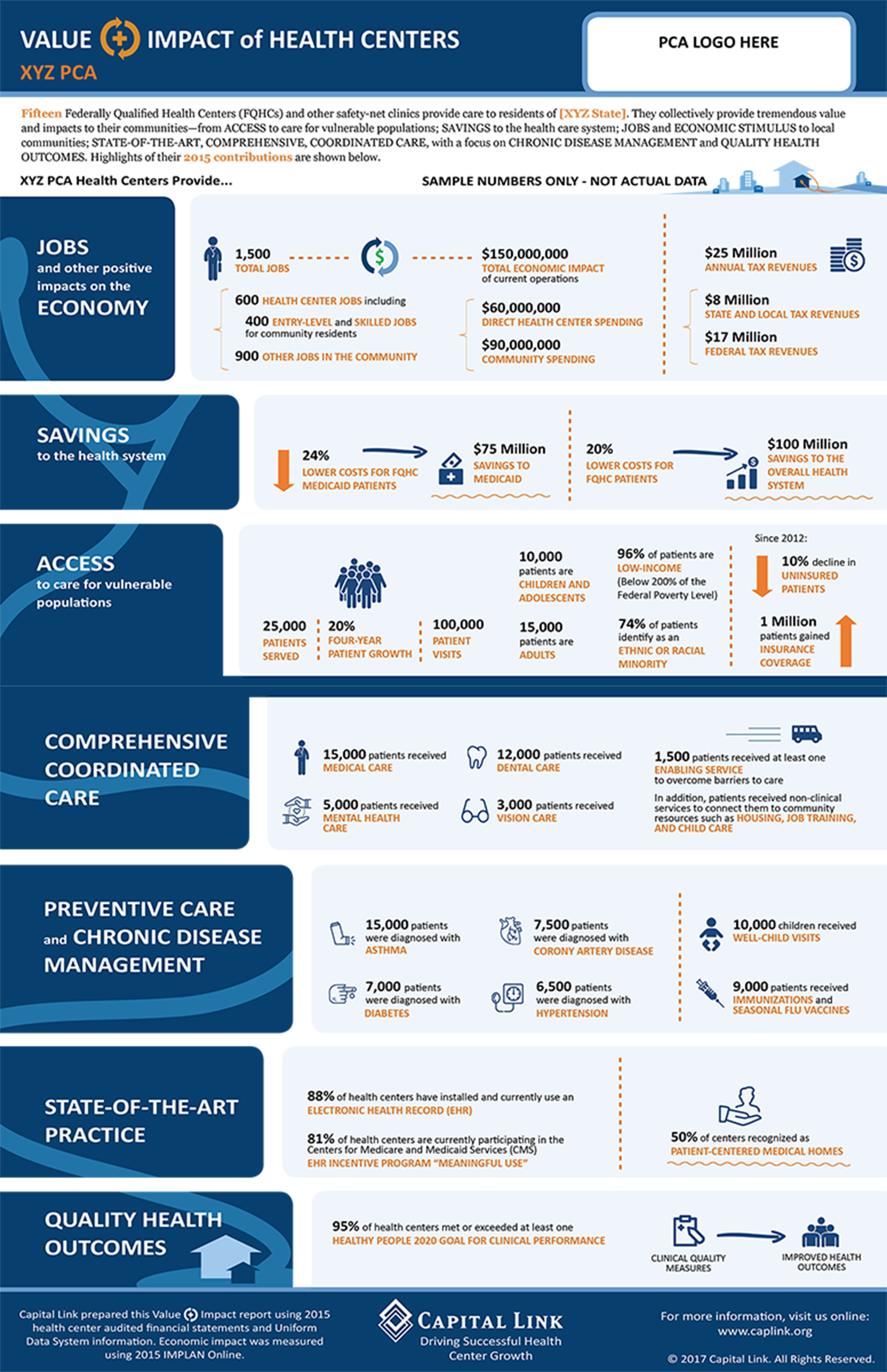New and Noteworthy
What Can Health Centers Do to Be Resilient During Uncertain Times?
The health care landscape is evolving and changing, but patients will still need access to care and health centers will need to serve them. Capital Link has delivered numerous trainings and developed a library of resources and tools to assist health centers in planning, whether the goal is growth, stabilization, or sustainability. It is particularly important now for health centers to operate efficiently and effectively, in order to weather whatever lies ahead. Below are some strategies to consider and resources available to health centers and PCAs:

Assess Your Financial and Operational Strength. The best way to prepare for tomorrow is to understand where you stand today by tracking performance and benchmarking results against peers and targets.
Related Resources, Services, and Programs:
-
Performance Benchmarking Toolkit for Health Centers (toolkit)
-
High-Performance Community Health Centers: Learning, Measuring, and Achieving (publication)
-
Performance Evaluation Profiles (service)
-
Financial Trends Snapshot (service)
-
Advancing Financial Strength (program)
-
High-Performance Community Healthcare: How to Measure It and How To Achieve It (webinar)
Understand Your Market. Health centers should have an understanding of their communities and the unmet needs in order to identify opportunities for growth and better programs of care.
Related Resources and Services:
-
Market Assessment for Service Expansion Rooted in the Community (upcoming webinar)
-
Market Assessment and Payer Mix Modeling in an Era of Health Reform (webinar)
-
NACHC State Level Data and Maps (various resources)
-
Market Assessment Process (service)
-
Community Asset Mapping (service)
-
NACHC’s Protocol for Responding to and Assessing Patients’ Assets, Risks, and Experiences, or PRAPARE (toolkit)
Develop a Strategic Business Plan. The health centers most prepared to respond to changing conditions have developed a dynamic strategic plan that they use actively.
Related Resources and Services:
-
Creating a Dynamic and Useful Strategic Plan: A Toolkit for Health Centers (toolkit)
-
Creating a Business Plan for a Community Health Center Capital Project: a “How-To” Manual (toolkit)
-
An Introduction to “Creating a Dynamic and Useful Strategic Plan”, a New Toolkit for Health Centers (webinar)
-
Incorporating Capital Plans and Capitalization Goals into Strategic Planning (webinar)
Develop Your Leadership and Workforce. For the insight and agility to react to change, health centers need to have a strong board and staff. They also need to have the ability to support team-based care, recruit and retain providers, and establish project teams for expansion plans.
Related Resources and Services:
-
Engaging Staff and Community in Defining Your Capital Project (publication)
-
Planning for Growth: Health Center Board and Staff Training (webinar)
-
An Introduction to Managing with Metrics (webinar)
-
NACHC’s Staffing the Safety Net: Building the Primary Care Workforce at America’s Health Centers (report)
-
NACHC’s Workforce Snapshot (fact sheet)
-
Creating a Healthcare Facility that Supports the Patient-Centered Medical Home (publication)
-
Creating a Place for Care: Fostering Alignment and Eliminating Barriers in the Patient-Centered Medical Home (publication)
-
Developing an Organizational Culture that Sustains the Patient-Centered Medical Home: Lessons Learned (publication)
-
Solutions, Training, and Assistance for Recruitment and Retention (STAR²) Center, project of the Association of Clinicians for the Underserved (resources and training)
Assess Your Capital Needs and Funding Sources. Understand your need for facilities and how to finance growth.
Related Resources and Services:
-
Capital Plans and Needs of Health Centers: A National Perspective (report)
-
Spotlight On Capital Resources series and Capital Project Financing resources (publications)
-
Adding Fund Development Capacity to Sustain Health Center Growth (publication)
-
Successful Health Center Project Stories (case studies)
-
Financing Health Center Projects with New Markets Tax Credits (webinar)
-
Accessing Capital from Community Development Financial Institutions (webinar)
-
HRSA’s Capital Development Grant Technical Assistance (online resource)
Communicate Your Value. Now more than ever, it is imperative that health centers document and demonstrate the valuable impact they have on the communities they serve on national, statewide, and local levels.
Related Resources and Services:
-
Value+Impact of Health Centers (report – learn more in the following article)
- HRSA's Year in Review (infographic)
Communicating Health Center Value
For more than 50 years, FQHCs have delivered comprehensive, high-quality preventive and primary health care services to patients regardless of their ability to pay. With revenues exceeding $21 billion in 2015, FQHCs constitute the largest network of primary care providers in the United States and the 2nd largest non-profit health system, behind only Kaiser Foundation Hospitals. If FQHCs were listed on the Fortune 500, they collectively would rank as number 133, on a par with Staples and ahead of Whirlpool, Starbucks, Kraft Heinz, and Facebook. However, as independently operated, locally-controlled nonprofit organizations, FQHCs focus on providing excellent care at the local level to their 24 million patients in the 9,800 urban and rural communities they serve.
In the wake of the election, health centers are facing the prospect of a changing financial landscape, driven by discussion of a potential repeal of the Affordable Care Act, a rollback and potential block-granting of Medicaid, and loss of 330 grant funding. Health centers need to demonstrate their value and communicate their impact to legislators and other stakeholders. The story of what health centers bring to their communities can be told along the following domains:
-
Employment and Economic Impacts
-
Savings to the Health Care System
-
Access to Care
-
Comprehensive Coordinated Care
-
Preventive Care and Chronic Disease Management
-
State-of-the-Art Practice
-
Quality Health Outcomes
To help PCAs, consortia, and HCCNs demonstrate the tremendous value of their member health centers statewide and within state and federal congressional districts, Capital Link has created Value+Impact of Health Centers, a new, enhanced version of our customized economic impact report and infographic. Click on the image below to view a sample.
We've also developed customized infographics illustrating the projected impact of a rollback to pre-ACA levels of Medicaid eligibility and insurance subsidies, and cuts to federal operating support. Click here to see a sample.
For more information about our Value + Impact infographics and reports, please contact Steve Rubman, Director of Data & Information Systems, at This email address is being protected from spambots. You need JavaScript enabled to view it. or 617-422-0350.
Accessing NMTC Allocations − Health Centers with Capital Projects Should Plan Now!
On November 17, 2016, the U.S. Department of the Treasury’s Community Development Financial Institutions Fund announced the awardees for the combined 2015-2016 round of New Markets Tax Credit (NMTC) allocations. The awards, which were increased to an historic high of over $7 billion, are aimed at revitalizing low-income communities and increasing economic opportunity nationwide. The 120 Community Development Entities (CDEs) that received these awards are actively seeking projects to finance. Many CDEs are interested in providing financing for community health center expansion and renovation projects, and the health centers that have projects further along in the planning process have a greater chance of success.
If your health center needs additional funding for a project, NMTC could be the answer. If you haven’t already obtained an allocation commitment for your project, it may be challenging to do so now, due to the great demand for credits. However, it’s not too soon to get your project ready for the next allocation round. While the program is authorized through 2020, it is unclear whether tax reform efforts in the 115th Congress could change or eliminate access to this important resource in the future.
NMTC financing is a critical source of low-cost capital and equity for health center facility projects—often subsidizing project costs by 20% to 25%. In order for health centers to obtain credits from a CDE, they must demonstrate a high level of project readiness and be able to communicate the merits of their projects to CDEs with allocation. Furthermore, the process of structuring and closing an NMTC transaction is complicated and the terms, benefits, and fees offered to borrowers vary widely.
Capital Link has extensive knowledge of the NMTC financing process and strong connections with virtually every CDE interested in working with health centers. Capital Link can provide assistance with the complex process of completing a NMTC transaction. Our lending affiliate, Community Health Center Capital Fund, can provide leverage loans to help complete the NMTC financing package, as needed. Of the nearly $1 billion in financing obtained by health centers through the NMTC program, approximately 60% was raised with Capital Link and/or Capital Fund assistance.
For help in determining whether NMTC financing could be a good fit for your health center, please contact us here.
To learn more about the NMTC program and how it works, click here to access Capital Link’s three NMTC publications and here to access a recording of the recent webinar, Financing Health Center Projects with New Markets Tax Credits.
![]()


